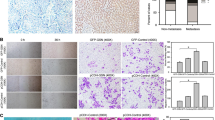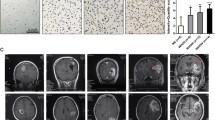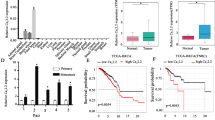Abstract
In the present study, we wanted to examine the predominant factor/s in the initiation of metastasis. We used samples of advanced grades of renal clear cell carcinoma with documented clinical history of vena caval spread as the experimental group. The major rationale for this selection is the fact that renal cell carcinoma metastasize extensively through the inferior vena cava up to the pulmonary bed and often exist as a continuous mass of metastatic tissue. As cortactin plays a significant role in invadopodia formation during initiation of metastasis, in the present study, we tested expression of cortactin and phosphotyr421-cortactin in different grades of renal cell clear carcinoma and examined its property to bind to actin. The findings of the present study suggest that the variations of the local physiological milieu are the driving forces for metastasis by enhancing molecular mechanisms for lamellipodia formation. We conclude that localization of cortactin in cancer cells and interaction between actin and its nucleators are crucial for cancer progression.




Similar content being viewed by others
References
McAllister SS, Weinberg RA. The tumour-induced systemic environment as a critical regulator of cancer progression and metastasis. Nat Cell Biol. 2014;16:717–27.
Orgaz JL, Herraiz C, Sanz-Moreno V. Rho GTPases modulate malignant transformation of tumor cells. Small GTPases. 2014;5:e29019.
Scheel C, Weinberg RA. Cancer stem cells and epithelial-mesenchymal transition: concepts and molecular links. Semin Cancer Biol. 2012;22:396–403.
Valastyan S, Weinberg RA. Tumor metastasis: molecular insights and evolving paradigms. Cell. 2011;147:275–92.
Nantajit D, Lin D, Li JJ. The network of epithelial-mesenchymal transition: potential new targets for tumor resistance. J Cancer Res Clin Oncol. 2014.
Gonzalez DM, Medici D. Signaling mechanisms of the epithelial-mesenchymal transition. Sci Signal. 2014;7:re8.
Derynck R, Muthusamy BP, Saeteurn KY. Signaling pathway cooperation in TGF-β-induced epithelial-mesenchymal transition. Curr Opin Cell Biol. 2014;31C:56–66.
Giarnieri E, Bellipanni G, Macaluso M, Mancini R, Holstein AC, Milanese C, et al. Review: cell dynamics in malignant pleural effusions. J Cell Physiol. 2014.
Moyret-Lalle C, Ruiz E, Puisieux A. Epithelial-mesenchymal transition transcription factors and miRNAs: “plastic surgeons” of breast cancer. World J Clin Oncol. 2014;5:311–22.
O’Connor JW, Gomez EW. Biomechanics of TGFβ-induced epithelial-mesenchymal transition: implications for fibrosis and cancer. Clin Transl Med. 2014;3:23.
Martin TA. The role of tight junctions in cancer metastasis. Semin Cell Dev Biol. 2014.
Wong TS, Gao W, Chan JY. Transcription regulation of E-cadherin by zinc finger E-box binding homeobox proteins in solid tumors. Biomed Res Int. 2014;2014:921564.
Chiodoni C, Colombo MP, Sangaletti S. Matricellular proteins: from homeostasis to inflammation, cancer, and metastasis. Cancer Metastasis Rev. 2010;29:295–307.
Wells A, Chao YL, Grahovac J, Wu Q, Lauffenburger DA. Epithelial and mesenchymal phenotypic switchings modulate cell motility in metastasis. Front Biosci (Landmark Ed). 2011;16:815–37.
Conti A, Santoni M, Amantini C, Burattini L, Berardi R, Santoni G, et al. Progress of molecular targeted therapies for advanced renal cell carcinoma. Biomed Res Int. 2013;2013:419176.
Géraud C, Koch PS, Damm F, Schledzewski K, Goerdt S. The metastatic cycle: metastatic niches and cancer cell dissemination. J Dtsch Dermatol Ges. 2014.
Khan MI, Czarnecka AM, Duchnowska R, Kukwa W, Szczylik C. Metastasis-initiating cells in renal cancer. Curr Signal Transduct Ther. 2014;8:240–6.
Singleton PA. Hyaluronan regulation of endothelial barrier function in cancer. Adv Cancer Res. 2014;123:191–209.
Ouderkirk JL, Krendel M. Non-muscle myosins in tumor progression, cancer cell invasion, and metastasis. Cytoskeleton (Hoboken). 2014;71:447–63.
Wang CL, Coluccio LM. New insights into the regulation of the actin cytoskeleton by tropomyosin. Int Rev Cell Mol Biol. 2010;281:91–128.
Chawla A, Mishra D, Bansal R, Chundru M. Rare sites of delayed metastasis in renal cell carcinoma. BMJ Case Rep. 2013;2013.
Casey RG, Raheem OA, Elmusharaf E, Madhavan P, Tolan M, Lynch TH. Renal cell carcinoma with IVC and atrial thrombus: a single centre’s 10 year surgical experience. Surgeon. 2013;11:295–9.
Abel EJ, Wood CG, Eickstaedt N, Fang JE, Kenney P, Bagrodia A, et al. Preoperative pulmonary embolism does not predict poor postoperative outcomes in patients with renal cell carcinoma and venous thrombus. J Urol. 2013;190:452–7.
Narumiya S, Tanji M, Ishizaki T. Rho signaling, ROCK and mDia1, in transformation, metastasis and invasion. Cancer Metastasis Rev. 2009;28:65–76.
Weed SA, Parsons JT. Cortactin: coupling membrane dynamics to cortical actin assembly. Oncogene. 2001;20:6418–34.
Schuuring E. The involvement of the chromosome 11q13 region in human malignancies: cyclin D1 and EMS1 are two new candidate oncogenes—a review. Gene. 1995;159:83–96.
Balzer EM, Whipple RA, Thompson K, Boggs AE, Slovic J, Cho EH, et al. c-Src differentially regulates the functions of microtentacles and invadopodia. Oncogene. 2010;29:6402–8.
Faragalla H, Al-Haddad S, Stewart R, Yousef GM. The significance of florid giant cell component in renal cell carcinoma: a case report and review of the literature. Can J Urol. 2010;17:5219–22.
Macdonald A, Horwitz AR, Lauffenburger DA. Kinetic model for lamellipodal actin-integrin ‘clutch’ dynamics. Cell Adhes Migr. 2008;2:95–105.
Eke I, Deuse Y, Hehlgans S, Gurtner K, Krause M, Baumann M, et al. β1 integrin/FAK/cortactin signaling is essential for human head and neck cancer resistance to radiotherapy. J Clin Invest. 2012;122:1529–40.
Zhang K, Wang D, Song J. Cortactin is involved in transforming growth factor-beta1-induced epithelial-mesenchymal transition in AML-12 cells. Acta Biochim Biophys Sin (Shanghai). 2009;41:839–45.
Boguslavsky S, Grosheva I, Landau E, Shtutman M, Cohen M, Arnold K, et al. p120 catenin regulates lamellipodial dynamics and cell adhesion in cooperation with cortactin. Proc Natl Acad Sci U S A. 2007;104:10882–7.
Kirkbride KC, Sung BH, Sinha S, Weaver AM. Cortactin: a multifunctional regulator of cellular invasiveness. Cell Adhes Migr. 2011;5:187–98.
Wang GC, Hsieh PS, Hsu HH, Sun GH, Nieh S, Yu CP, et al. Expression of cortactin and survivin in renal cell carcinoma associated with tumor aggressiveness. World J Urol. 2009;27:557–63.
Matsuo T, Miyata Y, Watanabe S, Ohba K, Hayashi T, Kanda S, et al. Pathologic significance and prognostic value of phosphorylated cortactin expression in patients with sarcomatoid renal cell carcinoma. Urology. 2011;78(2):476.e9–15.
Zhang Y, Zhang M, Dong H, Yong S, Li X, Olashaw N, et al. Deacetylation of cortactin by SIRT1 promotes cell migration. Oncogene. 2009;28(3):445–60.
Conflicts of interest
None
Author information
Authors and Affiliations
Corresponding author
Rights and permissions
About this article
Cite this article
Shen, HL., Liu, QJ., Yang, PQ. et al. Protein interactions of cortactin in relation to invadopodia formation in metastatic renal clear cell carcinoma. Tumor Biol. 36, 3417–3422 (2015). https://doi.org/10.1007/s13277-014-2976-8
Received:
Accepted:
Published:
Issue Date:
DOI: https://doi.org/10.1007/s13277-014-2976-8




